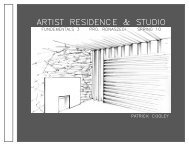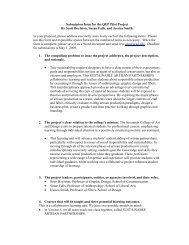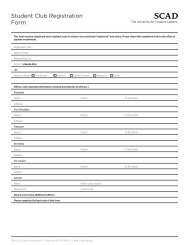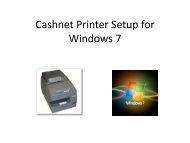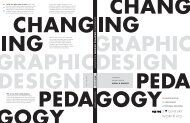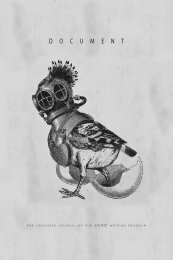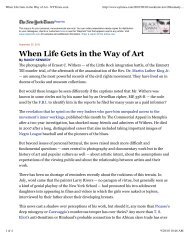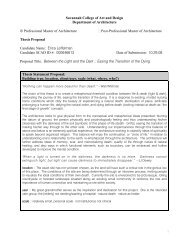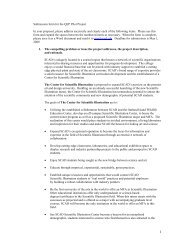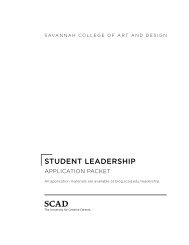How to get a job in fashion
How to get a job in fashion
How to get a job in fashion
You also want an ePaper? Increase the reach of your titles
YUMPU automatically turns print PDFs into web optimized ePapers that Google loves.
44<br />
45<br />
Portfolio (cont<strong>in</strong>ued)<br />
Portfolio (cont<strong>in</strong>ued)<br />
On the pages of your portfolio do highlight the span of acquired skills at your f<strong>in</strong>ger tips, your level<br />
of expertise with varied techniques, as well as your know-how with any and all computer technology.<br />
While we’re lay<strong>in</strong>g down the law, make a mental note <strong>to</strong> proceed with caution as far as the amount<br />
of material is concerned. Our advice is <strong>to</strong> go for detailed work rather than bulk; <strong>to</strong>o much stuff is<br />
confus<strong>in</strong>g. You won’t have the space <strong>to</strong> accommodate it and your <strong>in</strong>terviewers def<strong>in</strong>itely won’t take<br />
the time <strong>to</strong> look at it.<br />
On develop<strong>in</strong>g content<br />
Start with your school portfolio. You are after a series of fresh concepts, all of which are tar<strong>get</strong>ed<br />
at one particular cus<strong>to</strong>mer profile <strong>in</strong> a specific market. Read<strong>in</strong>g between the l<strong>in</strong>es, this means<br />
you should for<strong>get</strong> about <strong>in</strong>clud<strong>in</strong>g all your favorite sketches from the last three semesters!<br />
Zero <strong>in</strong> on the design category (or a comb<strong>in</strong>ation of categories) you choose, whether it’s kidswear,<br />
womenswear, menswear or others. That’s the professional approach you have <strong>to</strong> build <strong>to</strong>wards.<br />
On f<strong>in</strong>al content<br />
The portfolio you show must strike a chord with the company you are present<strong>in</strong>g it <strong>to</strong>. They should<br />
be able <strong>to</strong> relate <strong>to</strong> your work regard<strong>in</strong>g price po<strong>in</strong>t, fit and dist<strong>in</strong>ctive style. You want <strong>to</strong> stretch<br />
their imag<strong>in</strong>ations without blow<strong>in</strong>g their m<strong>in</strong>ds!<br />
It’s no secret that you don’t show even<strong>in</strong>g wear <strong>to</strong> active sportswear manufacturers, but <strong>to</strong> really<br />
focus your portfolio correctly, you have <strong>to</strong> know a th<strong>in</strong>g or two about the company you are<br />
<strong>in</strong>terview<strong>in</strong>g with. That’s why research<strong>in</strong>g is vital. You won’t be capable of meet<strong>in</strong>g their preferences<br />
if you don’t know who they are!<br />
On structure<br />
This portfolio conta<strong>in</strong>s a cohesive series of s<strong>to</strong>ries or groups, say a m<strong>in</strong>imum of three <strong>to</strong> a maximum<br />
of six, all geared <strong>to</strong>ward the same end cus<strong>to</strong>mer. The basic components of each group are:<br />
• an <strong>in</strong>spiration board<br />
• illustrations with fabrications and trims<br />
• flat sketches, both stylized and technical.<br />
If you do CAD work, you must <strong>in</strong>clude it either as a chosen medium for illustrations or flat<br />
sketches, or as an extra section follow<strong>in</strong>g the last group.<br />
On components<br />
• Inspiration board<br />
Sometimes referred <strong>to</strong> as a mood or trend board, this is the first glimpse potential employers<br />
will have of your <strong>in</strong>genuity. You <strong>in</strong>troduce the color palette here, ty<strong>in</strong>g it <strong>in</strong><strong>to</strong> the theme and<br />
suggest<strong>in</strong>g the feel. A collage of pho<strong>to</strong>graphs is the norm and any other material—from a candy<br />
wrapper <strong>to</strong> a silk thread or a strip of tree bark—that feels right and adds atmosphere or texture<br />
can work. The more <strong>in</strong>trigu<strong>in</strong>g these layouts of your design concepts are, the better. You might<br />
want <strong>to</strong> come up with an allur<strong>in</strong>g title. It’s your call.<br />
See page 53 for samples.<br />
• Full figure illustration spread<br />
This is how you present the correct proportions of the designs. Normally drawn two <strong>to</strong> three <strong>to</strong><br />
a page, full figures allow you <strong>to</strong> show how the garments drape and fit the body. They also serve<br />
as a means for communicat<strong>in</strong>g your <strong>in</strong>terpretations of the look by giv<strong>in</strong>g you a chance <strong>to</strong> mix<br />
and match coord<strong>in</strong>ated separates. Each spread tells a s<strong>to</strong>ry.<br />
The poses, attitudes and appearances of the figures you use will certa<strong>in</strong>ly <strong>in</strong>fluence how people<br />
perceive your s<strong>to</strong>ry. The arrangements of the figures on each page and even how the pages<br />
themselves relate <strong>to</strong> each other can make or break a strong s<strong>to</strong>ry idea.<br />
Fabric swatches and trims are quite effective when attached <strong>to</strong> the illustrations; it is handy <strong>to</strong><br />
show design, color and texture all at once. Of course, if you prefer, you may dedicate a page<br />
specifically <strong>to</strong> fabrics and trimm<strong>in</strong>gs.<br />
See page 54 for samples.<br />
• Flat sketches—both technical and stylized<br />
Although there are many styles of flat sketches, the 2 most commonly used are the technical<br />
flat sketch and the stylized flat sketch. Flat sketches, or flats, are just that: flat, two<br />
dimensional sketches of items. The function of a flat is <strong>to</strong> show a quick, black and white<br />
representation of a design.<br />
In the real world, companies depend on them throughout the production process from design <strong>to</strong><br />
product development, and always dur<strong>in</strong>g manufactur<strong>in</strong>g. The samples <strong>in</strong> your portfolio must be<br />
drawn as perfectly as possible because they will be exam<strong>in</strong>ed critically. It is best <strong>to</strong> show a nice<br />
mix of both types.<br />
• Use technical flats <strong>in</strong> your creative portfolio <strong>to</strong> illustrate the functionality of your designs.<br />
These sketches <strong>in</strong>clude all the necessary elements <strong>to</strong> show how a garment opens and<br />
closes—how it works. Clean l<strong>in</strong>es and correct proportions are necessities, but the<br />
design concept and feel still have <strong>to</strong> be obvious. Your technical flats should reference<br />
details like stitches, but<strong>to</strong>ns, box pleats, hidden zippers, etc.<br />
• Use stylized flats <strong>in</strong> your creative portfolio <strong>to</strong> provide a more animated view of your<br />
designs. These two dimensional representations of garments call <strong>to</strong> m<strong>in</strong>d draped figures.<br />
Drawn <strong>in</strong> correct proportions, stylized flats should also <strong>in</strong>clude all of the specific f<strong>in</strong>e<br />
po<strong>in</strong>ts for construction of a garment like collar details, sleeve length, but<strong>to</strong>ns, stitch<strong>in</strong>g,<br />
etc. Make sure yours are detailed enough.<br />
See pages 55-56 for samples.<br />
On sequence<br />
This is straightforward enough. To hold the attention of the viewer it is essential that your portfolio<br />
unfolds <strong>in</strong> a consistent manner. Our preferred sequence on the follow<strong>in</strong>g page is by no means the<br />
only way <strong>to</strong> proceed. You could, for <strong>in</strong>stance, slip <strong>in</strong> <strong>in</strong>troduc<strong>to</strong>ry pages for each group or you could<br />
decide <strong>to</strong> dedicate a page here and there <strong>to</strong> fabric swatches and trimm<strong>in</strong>gs. Admittedly, there is no<br />
right way, but <strong>to</strong> avoid go<strong>in</strong>g wrong, regard this as your basic template—at least for now.<br />
24 Seven, Inc.<br />
24 Seven, Inc.



